.gif) The year 2011 was uneventful for Indian education. With the political and national discourse dominated by the India Against Corruption movement led by Gandhian social reformer Anna Hazare, and Team Anna’s demand for a strong and effective Lok Pal Bill, reform and upgradation of education was relegated to the near bottom of the national agenda. Even as the anti-corruption movement attracted unpreced- ented support from the public, media and middle class, both houses of Parliament were regularly disrupted over the 2G, Commonwealth Games scams, and foreign direct investment in multi-brand retail among other issues with unruly MPs making it impossible for any well-considered legislation to be tabled, discussed and passed.
The year 2011 was uneventful for Indian education. With the political and national discourse dominated by the India Against Corruption movement led by Gandhian social reformer Anna Hazare, and Team Anna’s demand for a strong and effective Lok Pal Bill, reform and upgradation of education was relegated to the near bottom of the national agenda. Even as the anti-corruption movement attracted unpreced- ented support from the public, media and middle class, both houses of Parliament were regularly disrupted over the 2G, Commonwealth Games scams, and foreign direct investment in multi-brand retail among other issues with unruly MPs making it impossible for any well-considered legislation to be tabled, discussed and passed.
Regretably, the welfare of the world’s largest — and arguably most neglected — 450 million child population was ignored in this year of stasis in Indian education. Most of the reforms promised in 2009 by Union human resource development minister Kapil Sibal to radically transform and upgrade Indian education, have yet to be translated into reality two years later. A total of 12 pending Bills including NCHER (National Commission for Higher Education and Research), Foreign Educational Institutions (Regulation of Entry and Operations), National Accreditation Regulatory, Prevention of Malpractices, and Education Tribunals among other legislation for enacting overdue reforms in Indian education and higher education in particular, couldn’t be tabled in Parliament which was disrupted for 258 of its scheduled legislative 803 hours in 2011. Moreover with busybody HRD minister Kapil Sibal assuming additional charge of the Union telecom ministry and serving as a member of the Lok Pal Bill drafting committee, reform of the country’s crumbling primary, secondary and higher education systems received scant ministerial attention.
The Congress-led UPA-II government’s much-trumpeted Right to Free and Compulsory Education Act, 2009 (aka RTE Act), which completed its first anniversary on April 1 last year, has also proved to be a non-starter. In an official report released on the occasion (RTE Act: the 1st Year), the HRD ministry admitted that 8.1 million children in the age group six-14 remain out of school and there’s a shortage of 508,000 teachers countrywide, while only eight states and seven Union territories have notified Rules for implementing the Act — which makes it mandatory for the State (i.e Central, state and local governments) to provide free and compulsory education to every child between six-14 years — within their jurisdictions. Moreover the Supreme Court is dithering about pronouncing judgement on a clutch of writ petitions filed by private schools challenging the constitutional validity of several provi-sions of the Act, including the oblig-ation imposed upon them to provide highly subsidised primary education to “poor neighbourhood” children.
In the higher education sector as well, 2011 provided little cheer. Delhi Univer-sity’s 77 affiliated colleges sparked off a national outcry by hiking admission cut-off averages to 90-100 percent; a HRD ministry report revealed that 383,868 faculty positions are vacant in higher education institutions country-wide; and not even one Indian university was ranked in the Top 200 in the QS World University Rankings 2011 (see EW Cover Story December 2011).
However in a year of masterly inactivity in Indian education, there were slivers of good news. The Mamata Banerjee-led Trinamool Congress party, which ended 34 years of uninterrupted rule of the Communist Party of India-Marxist (CPM)-led Left Front govern-ment in West Bengal, announced that English language teaching will begin in class I in all 49,986 government primary schools in the state; the world’s cheapest tablet computer — Aakash — was launched with the HRD ministry setting itself a target of delivering 10 million tablets to post-secondary students across India in the coming months; a national RTE awareness campaign was inaugurated; and the Union cabinet approved a proposal to promote 2,500 model schools across the country under public-private partner-ships (PPP) as well as a final draft of the ambitious NCHER Bill, 2010.
Another positive development in Indian education in 2011 was that despite the thousand unnatural hurdles placed in their way by the neta-babu klepto-cracy which Anna Hazare is fighting tooth and nail, India’s new genre private edupreneurs, philanthropists and NGOs, driven by pressing middle class demand for globally benchmarked school and collegiate education, continued to promote and commission greenfield schools, colleges and universities, in the trademark Indian jugaad style.
In the following pages Summiya Yasmeen summarises the minor achievements of Indian education in the recently concluded year.
NCPCR’s RTE mandate
January 1. The National Commission for Protection of Child Rights (NCPCR) — an independent constitutional authority for monitoring effective implementation of the Right to Free and Compulsory Education Act 2009 (aka RTE Act) which makes it mandatory for the State to provide free and compulsory education to all children between ages six-14 countrywide — began its monitoring function for 18 states of the Indian Union. NCPCR created a separate division to oversee implementation of the RTE Act, and also a grievance cell to “inquire into complaints relating to child’s (sic) rights to free and compulsory education” as mandated under s.31(1)(a) of the Act. (Education News, EW January 2011)
ASER shock
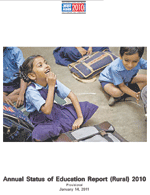 January 14. The Annual Status of Education Report 2010, compiled and published by the highly-respected Mumbai-based NGO Pratham, was released in New Delhi. ASER 2010 — compiled by over 25,000 volunteers (mainly higher secondary and under-graduate students) fanning out across 522 districts of rural India — assessed the actual learning outcomes in 13,000 (mainly government) primary schools countrywide.
January 14. The Annual Status of Education Report 2010, compiled and published by the highly-respected Mumbai-based NGO Pratham, was released in New Delhi. ASER 2010 — compiled by over 25,000 volunteers (mainly higher secondary and under-graduate students) fanning out across 522 districts of rural India — assessed the actual learning outcomes in 13,000 (mainly government) primary schools countrywide.
Inevitably as in the past six years since Pratham started this valuable initiative, ASER 2010 didn’t offer much cheer. Although the gross enrolment ratio in primary education rose from 95 percent in 2009 to 96.5 percent in 2010, the percentage of class V children who could read class II texts declined from 58 percent in 2007 to 53 percent in 2010, indicating that very little learning happens in the classrooms of rural primaries. Moreover ASER 2010 also recorded a decline in children’s maths learning capability. The proportion of class I children who could recognise numerals declined from 69.3 percent in 2009 to 65.8 percent in 2010. Likewise the percentage of class III children who can do two-digit subtraction sums declined from 39 percent to 36.5 percent even as the proportion of class V children who could complete simple division sums dropped from 38 to 35.9 percent. (Education News, EW February 2011; Special Report March 2011)
Teacher eligibility test mandatory
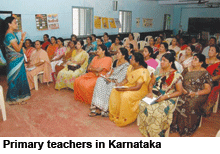 February 11. The National Council of Teacher Education (NCTE) issued guidelines to all state governments and Union territories for conducting the Teacher Eligibility Test (TET). In accordance with s.23 (1) of the RTE Act, NCTE made clearance of its TET mandatory for all new teachers with effect from the current academic year. According to the council, the minimum eligibility criteria to write TET is completion of Plus Two and a diploma/degree in education from a recognised teacher training institute. TET will be of 90-minutes duration with 150 multiple choice questions. The guidelines prescribe separate papers for teachers aspiring to teach primary (classes I-V) and upper primaries (classes VI-VIII).
February 11. The National Council of Teacher Education (NCTE) issued guidelines to all state governments and Union territories for conducting the Teacher Eligibility Test (TET). In accordance with s.23 (1) of the RTE Act, NCTE made clearance of its TET mandatory for all new teachers with effect from the current academic year. According to the council, the minimum eligibility criteria to write TET is completion of Plus Two and a diploma/degree in education from a recognised teacher training institute. TET will be of 90-minutes duration with 150 multiple choice questions. The guidelines prescribe separate papers for teachers aspiring to teach primary (classes I-V) and upper primaries (classes VI-VIII).
For some states, including Haryana, Gujarat, Madhya Pradesh and Chhattisgarh which have already devised teacher eligibility tests, it will mean realignment of their tests. But the new norms are likely to create problems in West Bengal, which was directed by the Union HRD ministry to amend its rules for recruitment of primary school teachers when it advertised 58,000 teachers’ posts specifying the minimum eligibility criterion as class X certification. However teacher recruits from states with poor teacher training facilities have been given the leeway to pass TET within five years. (Education News, EW March 2011)
Unicef’s SWC 2010 released
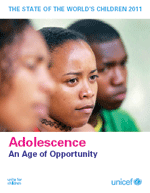 February 27. State of the World’s Children (SWC) 2011, an annual report of the United Nations Children’s Fund (Unicef), was released in New Delhi. SWC 2010 highlights India’s abysmal track rec-ord in adolescent health and educ-ation with almost 47 percent of girls in the 11-19 age group underweight — the highest percentage of any country worldwide — and 56 percent of girls and 30 percent of boys anaemic.
February 27. State of the World’s Children (SWC) 2011, an annual report of the United Nations Children’s Fund (Unicef), was released in New Delhi. SWC 2010 highlights India’s abysmal track rec-ord in adolescent health and educ-ation with almost 47 percent of girls in the 11-19 age group underweight — the highest percentage of any country worldwide — and 56 percent of girls and 30 percent of boys anaemic.
Moreover SWC 2010 states that of India’s 243 million children in the 11-19 age group, almost 40 percent are out of school and 43 percent marry before age 18, of whom 13 percent become teenage mothers. School attendance in the 11-13 age group is 86 percent, and 64 percent in the 14-17 age group. The report also says that 33 percent of adolescents report physical abuse and a similar percentage report sexual abuse. (Education Notes, EW March 2011)
Union Budget neglects education
.gif) February 28. Union finance minister Pranab Mukherjee presented Union Budget 2011-12 to Parliament. Professing awareness that “universalising access to secondary education, increasing the percentage of our scholars in higher education and providing skills training is necessary”, Mukherjee claimed credit for raising the Centre’s allocation for education by 24 percent over the past fiscal to Rs.52,057 crore in 2011-12. In his 110-minute budget speech, he also revised the operational norms of the Sarva Shiksha Abhiy-an programme to implement the Right to Education Act, 2009 and increased the SSA/RTE allocation from Rs.15,000 crore to Rs.21,000 crore in Budget 2011-12. Moreover he announced the promotion of a National Innovation Council headed by former National Knowledge Commission chairman Sam Pitroda and special grants to over a dozen institutions of higher education including IIT-Kharagpur and IIM-Calcutta.
February 28. Union finance minister Pranab Mukherjee presented Union Budget 2011-12 to Parliament. Professing awareness that “universalising access to secondary education, increasing the percentage of our scholars in higher education and providing skills training is necessary”, Mukherjee claimed credit for raising the Centre’s allocation for education by 24 percent over the past fiscal to Rs.52,057 crore in 2011-12. In his 110-minute budget speech, he also revised the operational norms of the Sarva Shiksha Abhiy-an programme to implement the Right to Education Act, 2009 and increased the SSA/RTE allocation from Rs.15,000 crore to Rs.21,000 crore in Budget 2011-12. Moreover he announced the promotion of a National Innovation Council headed by former National Knowledge Commission chairman Sam Pitroda and special grants to over a dozen institutions of higher education including IIT-Kharagpur and IIM-Calcutta.
However despite raising the education budget by 24 percent, the Centre’s allocation of Rs.52,057 crore aggregates to a mere 0.58 percent of the country’s GDP. (Cover Story, EW April 2011)
Supreme Court quashes AICTE notification
March 17. The Supreme Court issued a stay order against a notification of the Delhi-based All India Council of Technical Education (AICTE), which tightens the council’s control over the country’s 545 privately promoted independent (‘unaided’) business management schools.
Earlier on December 28, 2010, AICTE had issued an eight-point notification to all B-schools countrywide under which it outlawed several B-school entrance exams including the Xavier Admission Test (of XLRI, Jamshedpur), ATMA (administered by the Assoc-iation of Indian Management Schools) and MICAT (of the Mudra Institute of Communications, Ahmedabad). The AICTE notification also mandated that tuition fees charged by B-schools should have the approval of the fee fixation committees of state govern-ments; that all postgraduate diploma programmes offered should be of 24 months duration and that they should follow the council’s model curriculum. Aggrieved by AICTE’s notification to “put the clock back” and tighten — rather than loosen — its control over private unaided B-schools, the Association of Indian Management Schools and the Education Promotion Society of India among others, challenged AICTE’s notification prompting the apex court to issue the stay order. (Education News, EW April 2011)
RTE Act first anniversary
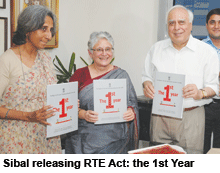 April 1. The Right to Free and Compulsory Education Act, 2009 (aka RTE Act) completed its first anniversary. On the occasion Union HRD minister Kapil Sibal released RTE Act: the 1st Year. According to this official report, 8.1 million children in the age group six-14 remain out of school and there’s a shortage of 508,000 teachers country-wide while only eight states and seven Union territories have notified the Rules for implementing the Act within their jurisdictions. The report, prepared by the Union HRD ministry, also presented a detailed progress report on elementary education (classes I-VIII) including student enrolment, number of teachers and infrastructure provision across the country.
April 1. The Right to Free and Compulsory Education Act, 2009 (aka RTE Act) completed its first anniversary. On the occasion Union HRD minister Kapil Sibal released RTE Act: the 1st Year. According to this official report, 8.1 million children in the age group six-14 remain out of school and there’s a shortage of 508,000 teachers country-wide while only eight states and seven Union territories have notified the Rules for implementing the Act within their jurisdictions. The report, prepared by the Union HRD ministry, also presented a detailed progress report on elementary education (classes I-VIII) including student enrolment, number of teachers and infrastructure provision across the country.
Simultaneously, a coalition of NGOs comprising NAFRE, Save the Children, Campaign against Child Labour, Unicef, Oxfam-India, National Coalition for Education among others, released their Stocktaking Report on the RTE Act on the eve of its first anniversary. This report describes the data of the official report as gross underestimates. According to this report, a mere five of the 28 states of the Indian Union have notified Rules for implementing the Act, the estimated overall teacher shortage is 1.4 million, and alleged that implem-entation of the RTE Act is being delayed due to the Centre and states disagreeing about the proportion in which they will share expenditure (a modest Rs.231,233 crore over five years). (EW Special Report, May 2011)
UPA II education achievements
.gif) May 22. The Congress-led UPA-II government’s self-appraisal document Report to the People 2010-11 was released in New Delhi to celebrate completion of the second year of its second term in office. The report claims that “one of our thrust areas has been expansion and strengthening of our education system at all levels — elementary, secondary and higher”.
May 22. The Congress-led UPA-II government’s self-appraisal document Report to the People 2010-11 was released in New Delhi to celebrate completion of the second year of its second term in office. The report claims that “one of our thrust areas has been expansion and strengthening of our education system at all levels — elementary, secondary and higher”.
In the foreword, prime minister Manmohan Singh takes credit for reducing the number of school drop-outs, expansion of the mid-day meal scheme to cover 110 million children in elementary education, promotion of girls hostels and ICT (information and communication technologies)-enabled education in secondary schools, and “strengthening a legislative framework by finalising or introducing in Parliament a number of Bills” for higher education reforms. (Education News, EW June 2011)
CABE endorses compulsory secondary schooling
June 7. The 58th meeting of the Central Advisory Board of Education (CABE) members was held in New Delhi. Chaired by Union HRD minister Kapil Sibal the CABE committee spent an entire day discussing ways and means to extend the ambit of the Right to Free & Compulsory Education Act, 2009 (aka RTE Act), which makes it mandatory for the State to provide free and compul-sory education to all children between six-14 years (classes I-VIII), to cover all secondary school children (classes IX-X) countrywide. Consequently a comm-ittee comprising ministers, educationists and members of civil society has been constituted to draft legislation to extend the ambit of the RTE Act to secondary school.
Other proposals discussed at the CABE meeting were a National Vocat-ional Education Qualification Framework to provide horizontal and vertical mobility for youth to graduate from general to vocational education; legislation to prevent and prohibit malpractices in school education; and reforms in the university affiliation system. (Education News, EW July 2011)
DU colleges stipulate record admission cut-offs
June 15. The 77 affiliated colleges of the Central government-funded Delhi University (DU) released their first ‘cut-off’ lists to admit 54,000 school-leaving students into undergraduate study programmes for the 2011-12 academic year. To limit the number of admission applications, most colleges hiked admission cut-offs by 12-14 percent to 90-100 percent with the Shri Ram College of Commerce management stipulating a 100 percent cut-off for science stream Plus Two students applying for admission into its B.Com (Hons) programme. Given the sky-high cut-offs, hundreds of students with 95 percent plus average in their class XII exam were denied admission into the courses/colleges of their choice.
According to Delhi University vice chancellor Dinesh Singh, the high cut-offs are the consequence of grades inflation in the school leaving class XII exams. For instance in 2009 the number of students who averaged 95 percent plus in the class XII CBSE exam was 200 while in 2010 the number shot up to 800. (Education News/ Special Report, EW July 2011)
Mamata introduces English in government schools
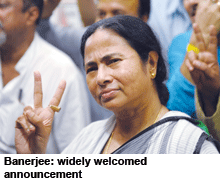 June 17. Within less than a month of being sworn in as chief minister of West Bengal after the Trinamool Congress party ended 34 years of uninterrupted rule of the Communist Party of India-Marxist (CPM)-led Left Front government in the state, Mamata Banerjee announced that English language teaching will begin in class I in all 49,986 government primary schools in the state (pop. 91.2 million), and that English will become a compulsory subject from class III. This announcement was widely welcomed by academics and educators across West Bengal.
June 17. Within less than a month of being sworn in as chief minister of West Bengal after the Trinamool Congress party ended 34 years of uninterrupted rule of the Communist Party of India-Marxist (CPM)-led Left Front government in the state, Mamata Banerjee announced that English language teaching will begin in class I in all 49,986 government primary schools in the state (pop. 91.2 million), and that English will become a compulsory subject from class III. This announcement was widely welcomed by academics and educators across West Bengal.
Earlier, following its historic win in the post-Emergency assembly election of 1977, one of the Left Front government’s first initiatives was to abolish English in primary schools (classes I-VII). Accordingly, the teaching of English was banned — even as a second language — in the state’s primary schools for 34 years. Now that English language teaching has been introduced from class I, the challenge before the newly inducted Mamata Banerjee government is to find English proficient teachers from within West Bengal’s 1.03 million teachers who were themselves denied English-medium instruction in some cases upto class X. (Education News, EW July 2011)
Azim Premji University gets going
July 11. The Bangalore-based Azim Premji University (APU) admitted its first batch of 200 students into its specially designed two-year Masters programmes in education development and teacher education. Promoted by the Azim Premji Foundation, APU is India’s first university exclusively focused on training education professionals and conducting education research. With a $2 billion or Rs.8,846 crore endowment by IT billionaire Azim Premji, the university is all set to emerge as the most well-funded education institution in Indian history with Rs.500 crore budgeted for first-phase infrastructure development, Rs.40 crore per year by way of faculty remuneration and generous means-tested student subsidies. (Cover Story, EW May 2011)
Apex court TN common school curriculum verdict
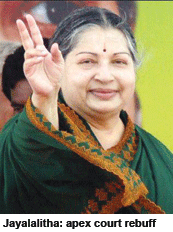 August 9. A three-judge bench of the Supreme Court directed Tamil Nadu’s newly elected AIADMK government to implement the common school curriculum mandated by the state government’s Uniform System of School Education (USSE) directive in all K-10 schools. The apex court dismissed the Jayalalitha-led AIADMK government’s appeal against a Madras high court order of July 18 upholding the Tamil Nadu Uniform System of School Education Act (TNUSSE) 2010, and quashed an amendment to s.3 of the Act introduced by the Jayalalitha government deferring implementation of the common curriculum.
August 9. A three-judge bench of the Supreme Court directed Tamil Nadu’s newly elected AIADMK government to implement the common school curriculum mandated by the state government’s Uniform System of School Education (USSE) directive in all K-10 schools. The apex court dismissed the Jayalalitha-led AIADMK government’s appeal against a Madras high court order of July 18 upholding the Tamil Nadu Uniform System of School Education Act (TNUSSE) 2010, and quashed an amendment to s.3 of the Act introduced by the Jayalalitha government deferring implementation of the common curriculum.
Citing 25 reasons for upholding the high court judgement, the bench held that the objective of the TNUSSE Act, 2010 was to provide uniform education statewide in the interest of quality education to all children, and that any objectionable content in textbooks could have been deleted by the Jayalalitha government as per directions given in the high court judgement by issuing executive directions instead of staying implementation of the Act for an indefinite period.
The Supreme Court verdict ended two months of litigation for and against the common school curriculum since May 18, after the newly sworn-in Jayalalitha government postponed the implement-ation of samacheer kalvi by amending s.3 of the TNUSSE Act on the ground that the common syllabus and textbooks prescribed were sub-standard. (Educa-tion News, EW September 2011)
Faculty shortage dampener
August 9. A task force appointed in September 2009 by the Union HRD ministry to examine ‘faculty shortage and design of performance appraisal system’ in higher education, submitted its report. It made the shocking revelation that 383,868 faculty positions (equal to 54 percent of sanctioned posts) are vacant countrywide. This estimate was based on data obtained by the task force during and after consultations with several vice chancellors of universities, representatives of higher education regulatory bodies, students and faculty countrywide. Faculty vacancies were calculated on the basis of a “realistic” 1:20.9 teacher-student ratio despite the University Grants Commission’s recommended 1:13.5 teacher-student ratio in tertiary education institutions.
Even more alarmingly, the high powered task force headed by IIT-Kanpur director, Prof. S.K. Dhande, estimated the nationwide faculty shortage during the next decade at 100,000 per year on the basis of an annual 6 percent growth in student enrolment. (Education News, EW September 2011)
Indian universities fare badly in QS rankings
September 5. The London-based Quacquarelli Symonds Ltd released its QS World University Rankings 2011 of 400 most respected universities worldwide. In the league table topped by Cambridge University, UK, not even one of India’s 603 universities or 31,000 colleges is ranked among the top 200. India’s top-ranked ‘university’ in the QS Top 400 league table is the Indian Institute of Technology-Delhi (IIT-Delhi) ranked 218 followed by IIT-Bombay (225) and IIT-Madras (281). Routinely ranked India’s best multi-disciplinary varsity by the media, the much-hyped Delhi University barely made it into the Top 400, ranked 398.
QS, which has been conducting research in higher education since 2004, shortlisted over 2,000 universities worldwide, evaluated 700 and ranked 400 in its latest 2011 survey. Universities are assessed on the parameters of academic reputation (40 percent peer assessment weightage); employer reputation (10 percent), citation per faculty (20 percent); faculty-student ratio (20 percent); proportion of international students (5 percent) and international faculty (5 percent).
India’s specialised institutions of higher learning — strictly speaking not quite universities — have been better ranked in faculty league tables. In the engineering and technology discipline/faculty, IIT-Bombay is ranked 47 worldwide and IIT-Delhi No.52 with IIT-Kanpur and IIT-Madras ranked 63 and 68 respectively.
EW ranks India’s top schools 2011
.gif) September 7. In the fifth annual EducationWorld Survey of India’s Most Respected Schools 2011, conducted by the Delhi-based market research and opinion polls age-ncy C fore, the Shri Ram School, Delhi; Rishi Valley School, Chittoor; and Woodstock School, Mussoorie were rated India’s top day, boarding and international schools respectively.
September 7. In the fifth annual EducationWorld Survey of India’s Most Respected Schools 2011, conducted by the Delhi-based market research and opinion polls age-ncy C fore, the Shri Ram School, Delhi; Rishi Valley School, Chittoor; and Woodstock School, Mussoorie were rated India’s top day, boarding and international schools respectively.
Over 100 C fore field researchers interviewed a mix of 2,044 principals, teachers and parents in 16 cities to constitute a representative sample base of knowledgeable SECA (socio-econ-omic category A in terms of education and occupation) respondents. They were asked to rate 404 day, boarding and international schools within their more familiar geographical regions (north, west, south and east) on 14 parameters of academic excellence — teacher welfare and development, competence of faculty, academic reputation, co-curricular activities, sports education, individual attention to students, discip-line and life skills education, infrastruc-ture, value for money, leadership/manag-ement quality, parental involvement, quality of alumni/students, disabled friendliness and community service. (Cover Story, EW September 2011)
Sibal launches world’s cheapest tablet computer
.gif) October 5. The world’s cheapest tablet computer — Aakash — was unveiled in New Delhi by Kapil Sibal, who wears the dual hat of Union minister of HRD and minister of communications and information technology. Originally named Sakshat, the tablet was subsequently branded Aakash (‘sky’). Speaking on the occasion, Sibal announced: “The rich have access to the digital world, the poor and ordinary have been excluded. Aakash will end that digital divide.”
October 5. The world’s cheapest tablet computer — Aakash — was unveiled in New Delhi by Kapil Sibal, who wears the dual hat of Union minister of HRD and minister of communications and information technology. Originally named Sakshat, the tablet was subsequently branded Aakash (‘sky’). Speaking on the occasion, Sibal announced: “The rich have access to the digital world, the poor and ordinary have been excluded. Aakash will end that digital divide.”
According to Sibal, the tablet project was commissioned by the ministry under NME-ICT (National Mission on Education through Information & Communications Technology) to Data Wind Ltd, a UK-based developer of wireless web access products and services. The ministry has set itself a target of delivering 10 million tablets to post-secondary students across India in the coming months. Originally expected to be priced at $35 (Rs.1,750) per unit, Aakash has been purchased by the Union government for Rs.2,250. The device offers Android 2.2 (Froyo) technology, a seven-inch touch screen, weighs a mere 350 gm with two-three hours of battery life at a stretch. (Education News, EW November 2011)
EW ranks India’s most admired preschools 2011
.gif) October 7. EducationWorld published its second league tables of India’s most admired pre-schools 2011, based on a survey conducted by Delhi-based market res-earch and opinion polls agency C fore in six cities — Delhi, Mumbai, Kolkata, Chennai, Bangalore and Hyderabad. In the 2011 survey of India’s Top 20 most admired preschools in each city, The Magic Years, Vasant Vihar was rated Delhi’s No. 1 preschool; Kangaroo Kids, Bandra (Mumbai’s No.1 preschool); EuroKids, Salt Lake (Kolkata); Vael’s Billabong High-Kangaroo Kids, Neelankarai (Chennai); Head Start Montessori (Bangalore) and EuroKids, Banjara Hills (Hyderabad).
October 7. EducationWorld published its second league tables of India’s most admired pre-schools 2011, based on a survey conducted by Delhi-based market res-earch and opinion polls agency C fore in six cities — Delhi, Mumbai, Kolkata, Chennai, Bangalore and Hyderabad. In the 2011 survey of India’s Top 20 most admired preschools in each city, The Magic Years, Vasant Vihar was rated Delhi’s No. 1 preschool; Kangaroo Kids, Bandra (Mumbai’s No.1 preschool); EuroKids, Salt Lake (Kolkata); Vael’s Billabong High-Kangaroo Kids, Neelankarai (Chennai); Head Start Montessori (Bangalore) and EuroKids, Banjara Hills (Hyderabad).
An aggregate respondents sample comprising 1,397 SEC (socio-economic category) A parents with a median income of Rs.30,000 per month and at least one child in preschool, and 334 principals/teachers were quizzed by C fore field researchers and asked to rate preschools on ten parameters including competence of teachers, infrastructure, individual attention to students, value for money, parental involvement, innovative teaching, safety and hygiene, leadership quality, special needs education and play facilities. (Cover story, EW October 2011)
RTE national awareness campaign launched
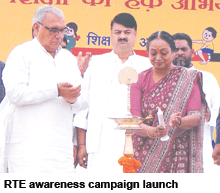 November 11. On the birth anniversary (November 11) of India’s first education minister, Maulana Abul Kalam Azad, officially designated National Education Day, the Union government rolled out a massive campaign to create public awareness about the historic Right to Education (RTE) Act, 2009, which became law on April 1, 2010, to enable its speedier implementation. On the day, 1.25 million schools across the country listened to an inspiring message from prime minister Dr. Manmohan Singh, read to over 200 million children by school principals in the presence of teachers, school development manag-ement committees and local government officials in 14 languages. The campaign was symbolically launched from Nuh in Mewat (Haryana) — one of the country’s most educationally backward districts — by Union HRD minister Kapil Sibal, who read the PM’s message there.
November 11. On the birth anniversary (November 11) of India’s first education minister, Maulana Abul Kalam Azad, officially designated National Education Day, the Union government rolled out a massive campaign to create public awareness about the historic Right to Education (RTE) Act, 2009, which became law on April 1, 2010, to enable its speedier implementation. On the day, 1.25 million schools across the country listened to an inspiring message from prime minister Dr. Manmohan Singh, read to over 200 million children by school principals in the presence of teachers, school development manag-ement committees and local government officials in 14 languages. The campaign was symbolically launched from Nuh in Mewat (Haryana) — one of the country’s most educationally backward districts — by Union HRD minister Kapil Sibal, who read the PM’s message there.
The Union government’s shiksha ka haq (‘right to education’) is a first-of-its-type campaign and will rope in 200,000 volunteers and hundreds of community-based organisations to take the campaign door-to-door over the next year, with the objective of prompting all 1.25 million elementary schools countrywide to become RTE compliant by March 31, 2013. (Education News, EW November 2011)
PPP model schools approved
November 24. The Union cabinet approved in principle a proposal to promote 2,500 model schools across the country under public-private partner-ships (PPP). The schools will be established during the 12th Plan (2012-17) period. The proposal envisages primary-secondaries focused upon teaching science, maths and English, and bridge-courses for academically weak students.
According to government sources, each school will have a capacity of 2,000 with the Centre sponsoring 980 students. The remaining 1,000-plus seats will be allocated at the discretion of private managements who will be obliged to purchase land and construct buildings. The schools will admit students in classes VI-XII and will be affiliated with the Delhi-based Central Board of Secondary Education. The government has budgeted a total of 6,000 model schools, of whom 2,500 will be established under PPP. (Education Notes, EW November 2011)
Common management test launched
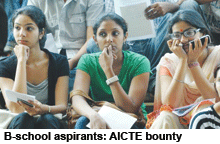 December 5. The Delhi-based All India Council for Technical Education (AICTE) launched the first national Common Management Admission Test (CMAT)-2012 to facilitate admission of students into business management schools approved by it countrywide. According to AICTE, the CMAT is necessary to address complaints of physical, mental and financial stress being imposed on aspiring business management students who have to write a number of entrance examinations conducted by B-schools across the country.
December 5. The Delhi-based All India Council for Technical Education (AICTE) launched the first national Common Management Admission Test (CMAT)-2012 to facilitate admission of students into business management schools approved by it countrywide. According to AICTE, the CMAT is necessary to address complaints of physical, mental and financial stress being imposed on aspiring business management students who have to write a number of entrance examinations conducted by B-schools across the country.
CMAT-2012 will be conducted online in 61 cities from February 20-28, 2012 and scores awarded will be used for admission into postgraduate manage-ment programmes both at degree and diploma levels for the year 2012-13 in all AICTE-approved B-schools.
Cabinet clears NCHER Bill
December 21. The Union cabinet cleared the National Commission of Higher Education and Research (NCHER) Bill 2010, which envisages an overarching body in higher education to supervise universities and technical institutes. The NCHER will subsume all existing regulatory bodies, including UGC, AICTE and Council of Distance Education, and will comprise 70 mem-bers, with representatives from every state and regulatory bodies. The proposal to establish NCHER was recom-mended by the Yash Pal Committee and the National Knowledge Commission.
NCHER will oversee all areas and disciplines, including general, technical and professional education, and some research areas of medicine.